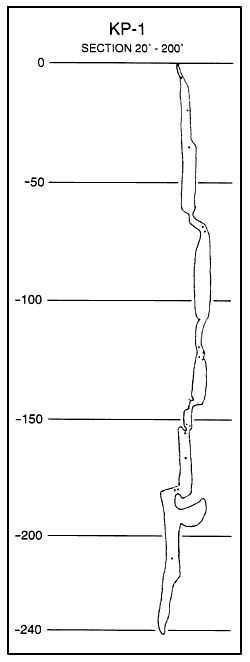|
After a thorough examination of the water passage which linked Mornig cave with Comici cave, we concluded that the logical target of the further exploration was the Ramo degli Inglesi series. The series is located in the point where a considerable amount of water flows from Abisso Mornig cave into Abiusso Emilo Comici cave. The above series had been visited only once, long time ago, by the Italian-British team. However, due to threat of water rise, they did not manage to complete the exploration. Unfortunately, neither did we. Therefore, we still do not know what happens to the water flowing into the Ramo degli Inglesi.
|
|
The Julian
Alps
- Slovenia
Lubomir Zawierucha
Speleoklub Bielsko-Biala
Speleoklub Bielsko-Biala made two summer exploratory expeditions to the Julian Alps in Slovenia in 1993 and 1994. We worked in the area of Kriški Podi in the Triglav National Park. The expeditions were made possible by the assistance of Professor Jurij Kunaver from the university in Ljubljana, to whom we herewith express our sincere thanks.
Our activity was focused on the area between the peak Razor (2601 m) and Kriški Podi and its surrounding. The area is delimited on the east by the valley of Vrata, on the south by the valley of Zadnijca, on the west by the Vršič pass, and on the north by the Krnica valley.
Kriški Podi are built of massive Dachstein Limestone, up to 2000 m thick. The strata dip generally southeast. The whole massif is bound by two deep faults, one running along the line Krajnska Gora - Vršič pass - Zadnja Trenta bounds the exploration area on the west and the other one - Luknja - Zadnjica - bounds it on the east. A distinct submeridionally running fault is discernible within the area of exploration along the valley east of Razor. There is also a network of fractures perpendicular to the Luknja fault. They control the numerous depressions in the relief (rifts, clefts, hanging valleys, deeply incised passes).
The area of exploration is situated above 1900 m and it lies above the timberline. Annual precipitation exceeds 2000 mm. The whole area has typical forms of alpine karst. Vast areas are covered with lapies. Its main concentration occurs within the glacial cirque Zgornje and Srednje Kriška Jezero, Stenarjeva Planja, eastern part of the valley and below Razor, and

| | |

|

























